0 引言
我国的矿井多为高瓦斯矿井,当瓦斯体积分数为5%~16%时就有可能发生爆炸,安全形势严峻。矿井瓦斯浓度允许值为1%,因此,对矿井各位置瓦斯浓度进行实时监测至关重要。瓦斯主要成分为甲烷,占80%以上。目前煤矿井下主要采用催化燃烧式、热导式和红外式甲烷传感器实时监测甲烷浓度,这些传感器均采用有线供电模式,监测范围较小。通过部署分布式无线甲烷传感器可实现大范围甲烷监测,同时利用网络化传输平台,将各个位置的甲烷浓度监测信息实时传送至控制台,可进一步解决瓦斯安全问题[1-3]。分布式无线甲烷传感器技术要求甲烷传感器功耗低、微型化、响应时间短、可靠性高、安全性好。目前传统矿用甲烷传感器均难以完全满足分布式无线甲烷传感器应用要求。催化燃烧式或热导式甲烷传感器功耗非常高,而红外式甲烷传感器成本较高、结构复杂,故而新型低功耗甲烷传感器的研究十分必要和紧迫[4-5]。
随着科学技术的发展,纳米技术和微机械电子系统(Micro-Electro-Mechanical System,MEMS)技术使得低功耗矿用甲烷传感器有了实现的可能。纳米技术主要指将材料加工到纳米量级的尺寸大小的技术。当材料的尺寸缩小到纳米大小时,材料的比表面积会迅速增大,从而出现很多特殊的性质,有利于气体响应,如量子效应等。MEMS技术主要指应用传统的半导体制造技术,如光刻、刻蚀、薄膜沉积等技术,制造出微米量级的精密机械电子部件。MEMS技术涉及微电子、材料、力学、化学、机械等学科,可以实现高集成度低功耗甲烷传感元件,从而促进分布式无线甲烷传感器技术发展,保障煤矿生产安全。
本文对基于MEMS技术和纳米材料的低功耗甲烷传感器的工作原理和研究进展进行了系统介绍,并分析了低功耗甲烷传感器的优缺点,展望了低功耗甲烷传感器的发展方向和前景,为后续进一步研究低功耗甲烷传感器提供参考。
1 低功耗甲烷传感器工作原理
按照工作原理,甲烷传感器可分为催化燃烧式、热导式、电导式等。目前低功耗甲烷传感器的研究主要集中在2个方面:一是传感器结构的优化,主要通过微纳加工得到MEMS型甲烷传感器;二是材料的改进,如改进封装材料或者气体敏感材料等。
1.1 低功耗催化燃烧式甲烷传感器
低功耗催化燃烧式甲烷传感器由铂丝、催化剂与载体构成,如图1所示。铂丝不仅是加热丝,也是热敏电阻。当甲烷氧化燃烧放热时,铂丝温度升高,电阻值增大,电压发生变化,从而可检测出甲烷浓度。催化燃烧式甲烷传感器信号一般在甲烷体积分数为0~5%时呈线性,故可用于检测爆炸下限范围内的低浓度甲烷。
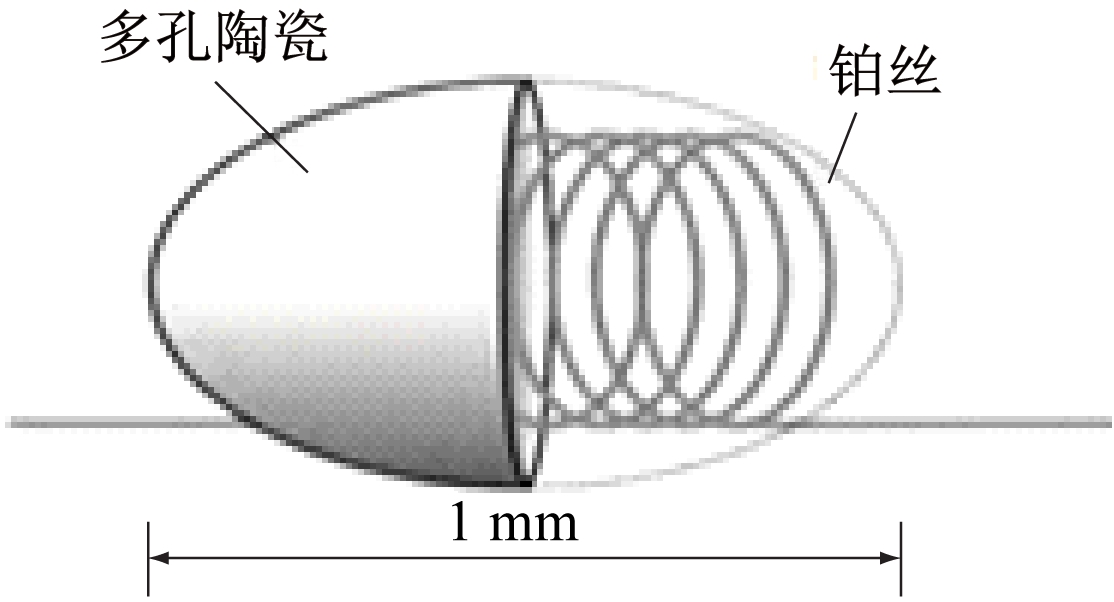
图1 低功耗催化燃烧式甲烷传感器结构
Fig.1 Structure of low-power catalytic
combustion methane sensor
1.2 低功耗热导式甲烷传感器
低功耗热导式甲烷传感器结构如图2所示,利用甲烷和空气的热导率不同实现甲烷浓度的测量,核心为热敏元件,通常使用钨丝、铂丝或者镍-铁合金加热丝。当空气中存在甲烷时,气体的热导率增大,敏感元件表面散热加快,温度降低,电阻值减小。通过测量敏感元件的电阻值可计算出甲烷浓度。该类传感器灵敏度很低,主要用于测量高体积分数(4%~100%)的甲烷。
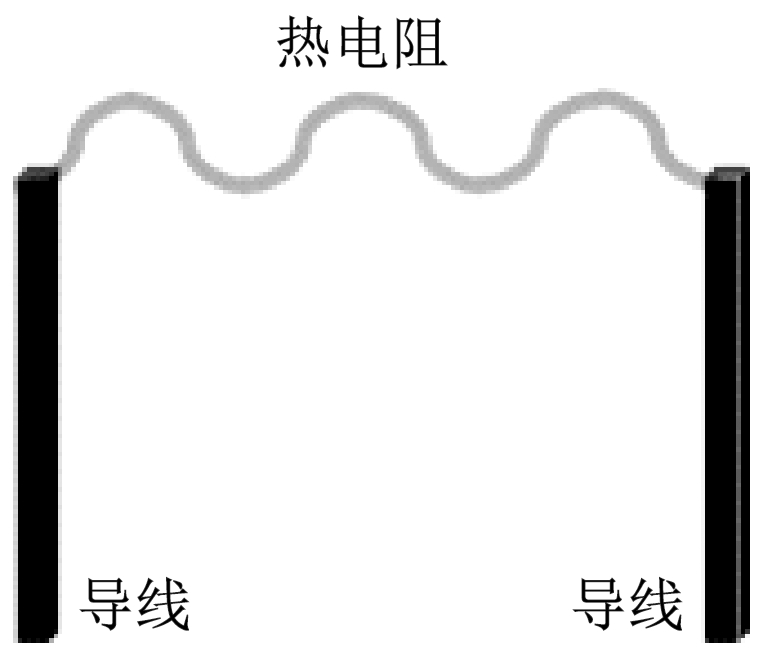
图2 低功耗热导式甲烷传感器结构
Fig.2 Structure of low-power thermal
conductivity methane sensor
1.3 低功耗电导式甲烷传感器
低功耗电导式甲烷传感器结构如图3所示,利用气体敏感材料的电阻值随甲烷浓度呈线性变化的原理测量甲烷浓度。气体敏感材料一般为金属氧化物半导体,如氧化锡、氧化锌等,也有报道基于碳纳米管或者石墨烯的电导式甲烷传感器。该类甲烷传感器灵敏度高,甲烷最小探测体积分数达到了0.05%。

图3 低功耗电导式甲烷传感器结构
Fig.3 Structure of low-power electrical
conductivity methane sensor
2 低功耗甲烷传感器研究进展
2.1 低功耗催化燃烧式甲烷传感器
C.Ducso等[6]设计了基于铂加热器微加热板的微型催化燃烧式甲烷传感器,并成功地在加热器下方引入了微型支撑柱,增强了加热器的力学性能,然而由于热传导效应,器件功耗相比无支撑柱的传感器有所增加。Lu Xiaoqing等[7]利用MEMS工艺设计了催化燃烧式甲烷传感器,并比较了钯、铑、铂3种不同催化剂的工作温度,钯催化剂的工作温度最低,而铂催化剂的工作温度最高,因此,钯催化剂是最合适的催化剂材料。Xu Lei等[8]比较了二维和三维微加热板的催化燃烧式甲烷传感器的性能,尽管功耗和响应时间差别不大,但是三维微加热板的甲烷传感器灵敏度是二维微加热板加热传感器的2倍多,微加热板尺寸如图4所示。
W.J.Jang 等[9]设计了微型催化燃烧式甲烷传感器,该传感器由传感部分和补偿部分组成,当输入功率为104 mW时,微型传感器对体积分数为4.630×10-3和3.473×10-3的甲烷的输出电压分别为0.727 mV和0.548 mV。Su Jiacan等[10]设计了基于2种不同催化剂体系的微型催化燃烧式甲烷传感器,即介孔氧化铑-氧化铝体系和钯铂双金属-氧化铝体系。经过比较,氧化铑-氧化铝体系可形成更均一的介孔结构,且比表面积更大。此外,该体系催化活性更高,对甲烷催化燃烧反应的稳定性更好。微型催化燃烧式甲烷传感器的响应时间少于8 s,信号输出达2.1 mV/0.4% CH4。E.K.Evgeny 等[11]在阳极氧化铝薄膜上制备了平面型的催化燃烧式甲烷传感器,该传感器使用模拟电路,而非惠斯通电桥结构,只使用1个传感器,同时作为工作和参比传感器,使其在200 ℃和400 ℃下工作,从而补偿湿度和环境温度的影响。传感器采用脉冲方式运行,平均运行功耗为1.18 mW,结构如图5所示。

(a) 二维微加热板
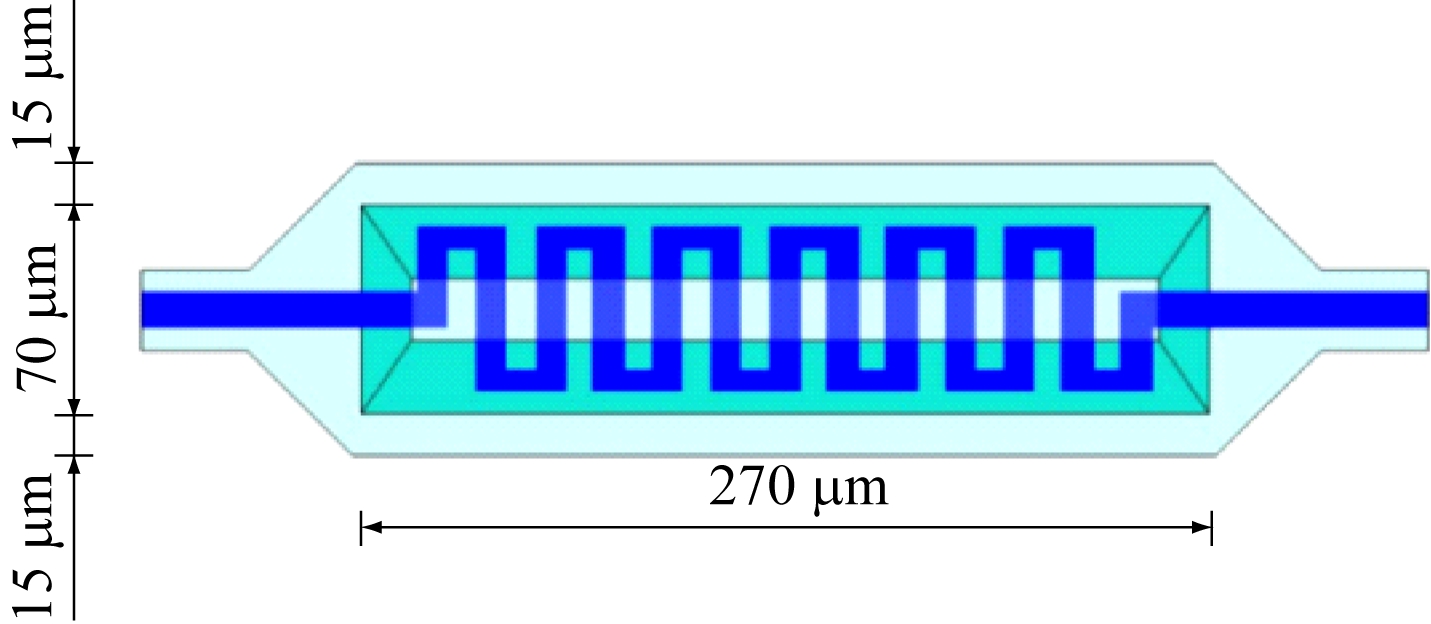
(b) 三维微加热板
图4 微加热板尺寸
Fig.4 Dimension of microhotplate
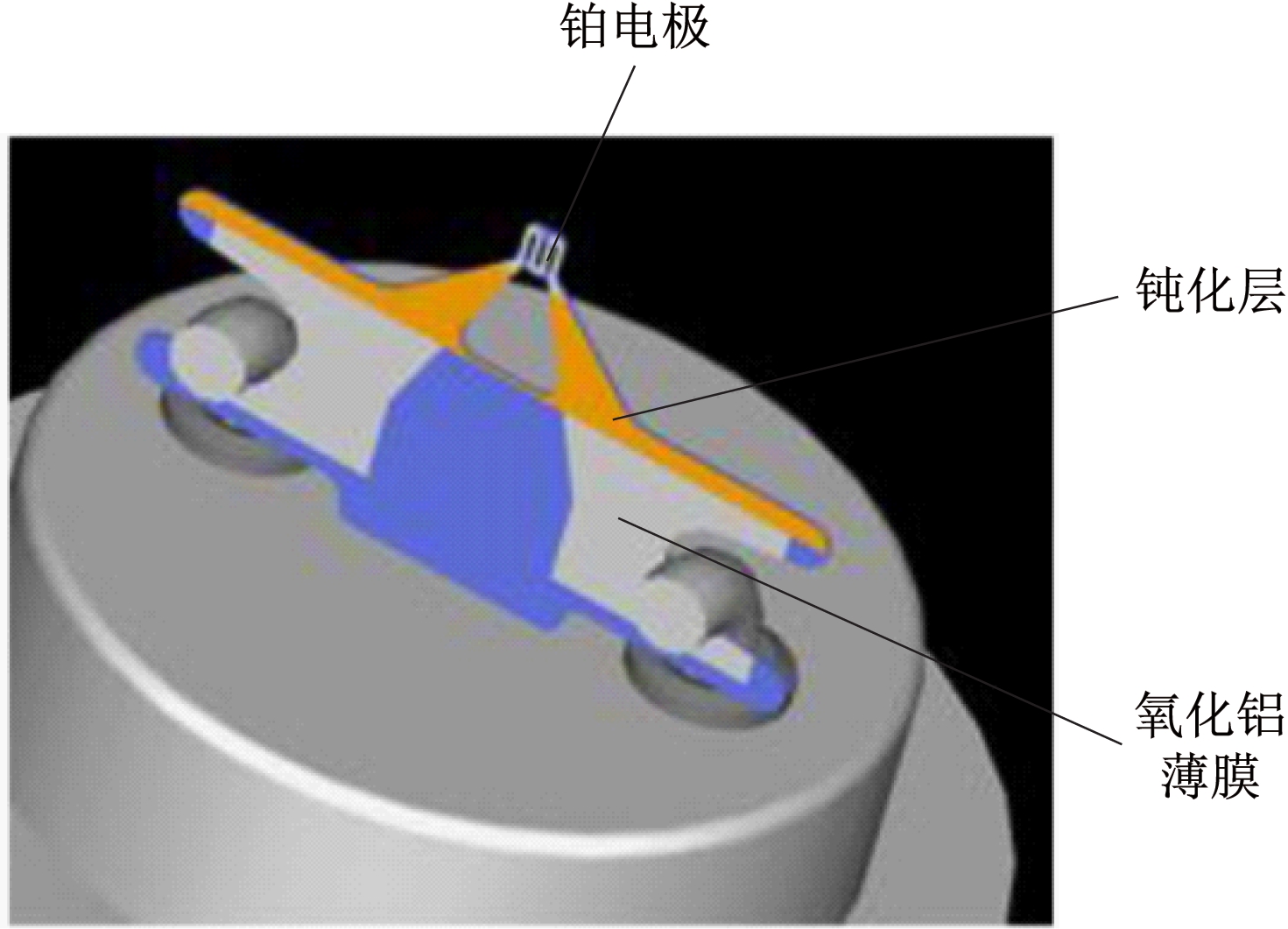
图5 平面型催化燃烧式甲烷传感器结构
Fig.5 Structure of planar type catalytic
combustion methane sensor
Ma Hongyu等[12]采用憎水性硅气凝胶对催化燃烧式甲烷传感器进行了封装,使功耗降低了30%左右,同时实现了高敏感度。这是由于硅气凝胶具有较低的热导性和较高的透气性,使热量保留在传感器内部。Lu Wenshuai等[13]利用高分辨率丝网印刷技术首次在块状熔融石英基底上制备了微型催化燃烧式甲烷传感器,在300 ℃时,该传感器敏感度为0.77 mV/1%CH4,功耗为415 mW,响应时间为35 s。Lu Wenshuai等[14]在500 μm厚的石英基底上制备了背面微孔的微型催化燃烧式甲烷传感器,该传感器在450 ℃工作时功耗为285 mW,敏感度为1.83 mV/1%CH4,响应时间为8.8 s。
综上所述,由于工作温度较高,催化燃烧式甲烷传感器的功耗一般较高;通过采用脉冲方式运行,并使用模拟电路,传感器平均功耗可以降低至2 mW以下。
2.2 低功耗热导式甲烷传感器
C. Dusco等[6]利用热导式传感器成功测量了体积分数为2%~10%的甲烷,该传感器由2个大小相同但热性质不同的部分组成,即1个微加热板和1个涂有多孔陶瓷的微加热板组成惠斯通电桥。热交换能力不同会导致偏压,从而可测量出甲烷浓度。I.Barsony 等[15]利用MEMS催化燃烧式甲烷传感器和热导式甲烷传感器组成阵列测得甲烷浓度。 Ma Hongyu等[16]设计了基于硅悬臂的热导式甲烷传感器,该传感器可测量低浓度甲烷,输入信号大于10 mV/1% CH4,具有替代催化燃烧式甲烷传感器测量矿井低浓度甲烷的潜力。Ma Hongyu等[17]通过在绝缘体上硅(Silicon-on-Insulator,SOI)基底上制备微加热器,设计了MEMS型热导式甲烷传感器。该传感器可在650 ℃工作,功耗低于50 mW,敏感度达到22 mV/1%CH4,如图6所示。在脉冲模式下该传感器的响应和回复时间分别为10 ms和1 ms,如图7所示。MEMS型热导式甲烷传感器响应快速的原因是尺寸小、质量小和响应原理未涉及化学反应或者化学物理吸附过程[17]。
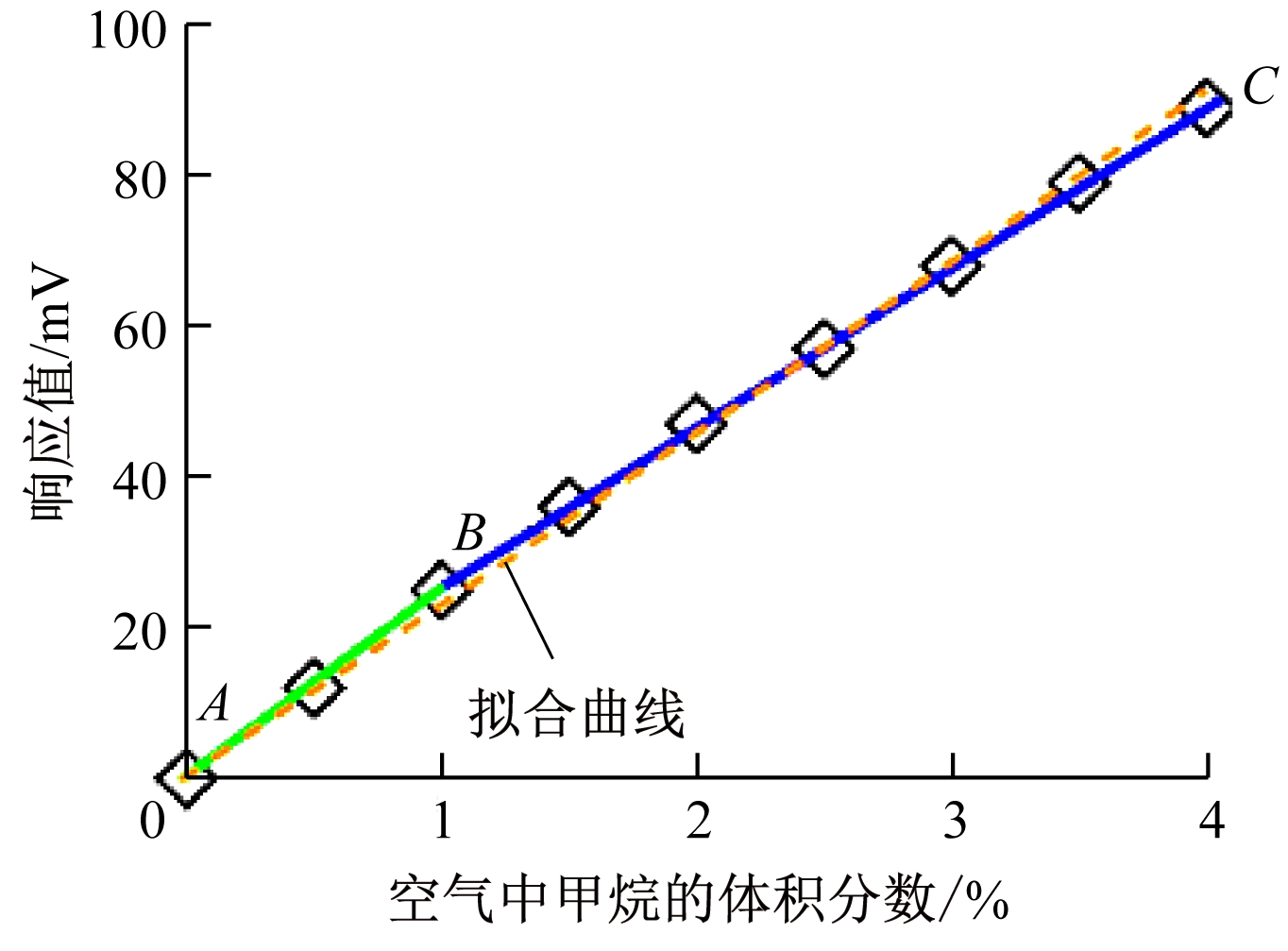
图6 热导式甲烷传感器对不同体积分数的
甲烷的响应值曲线
Fig.6 Response value curves of thermal conductivity
methane sensor to different volume fractions of methane
Ma Hongyu等[18]利用焦耳自加热效应得到微区高温的热导式甲烷传感器。该传感器主要由硅悬臂微加热器构成,如图8所示。该传感器可以测量体积分数为0~17%的甲烷,功耗约为27 mW,灵敏度达到了20 mV/1%CH4,如图9所示。功耗和响应与悬臂的长度相关,悬臂长度越长,功耗越低,灵敏度越高[18]。该传感器具有灵敏度高、稳定性好、寿命长、抗污染等优点。由于采用MEMS工艺制备,易于批量生产,并具有批量校准的潜力。该新型低功耗甲烷传感器也易于集成到智能矿灯中。
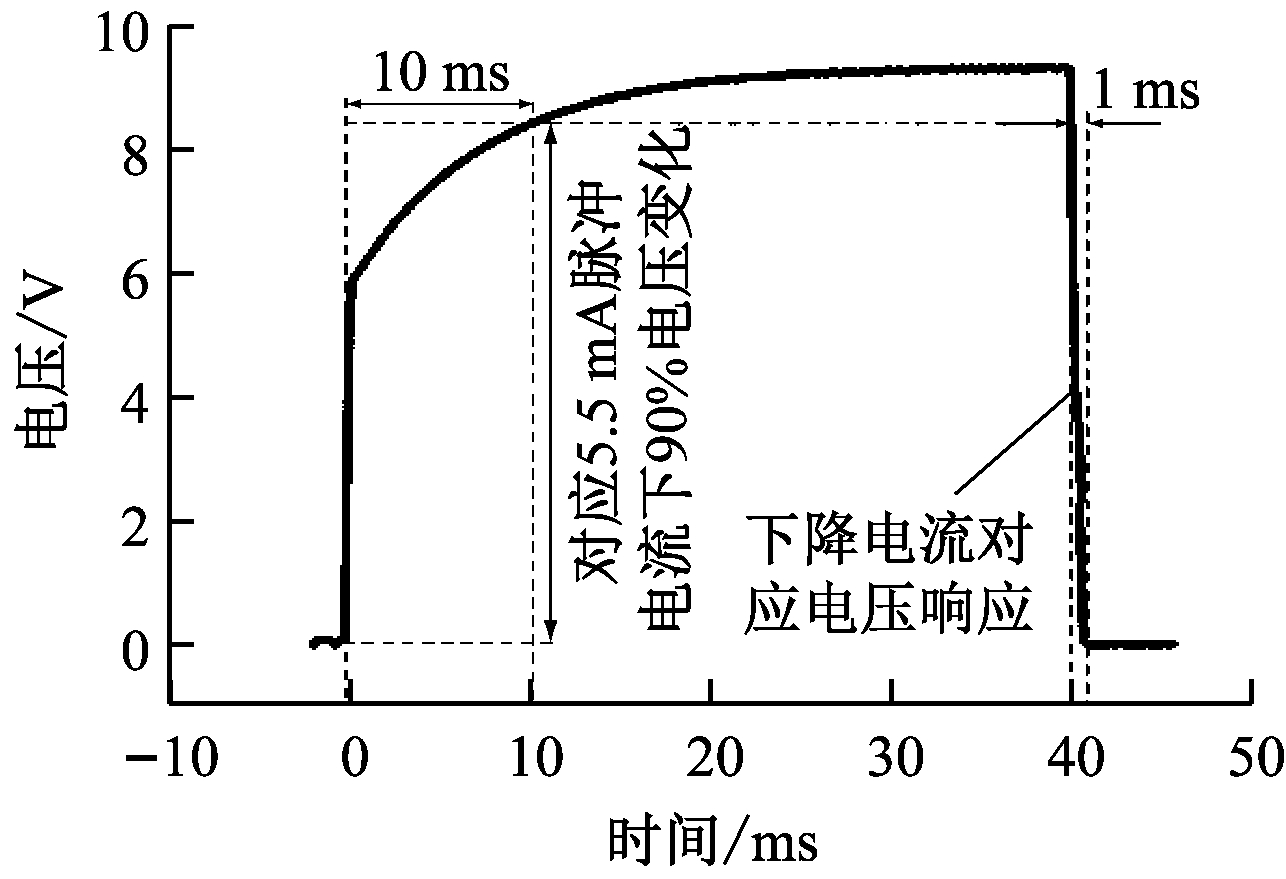
图7 脉冲模式下热导式甲烷传感器对甲烷的响应曲线
Fig.7 Response curves of thermal conductivity methane
sensor to methane in pulse mode
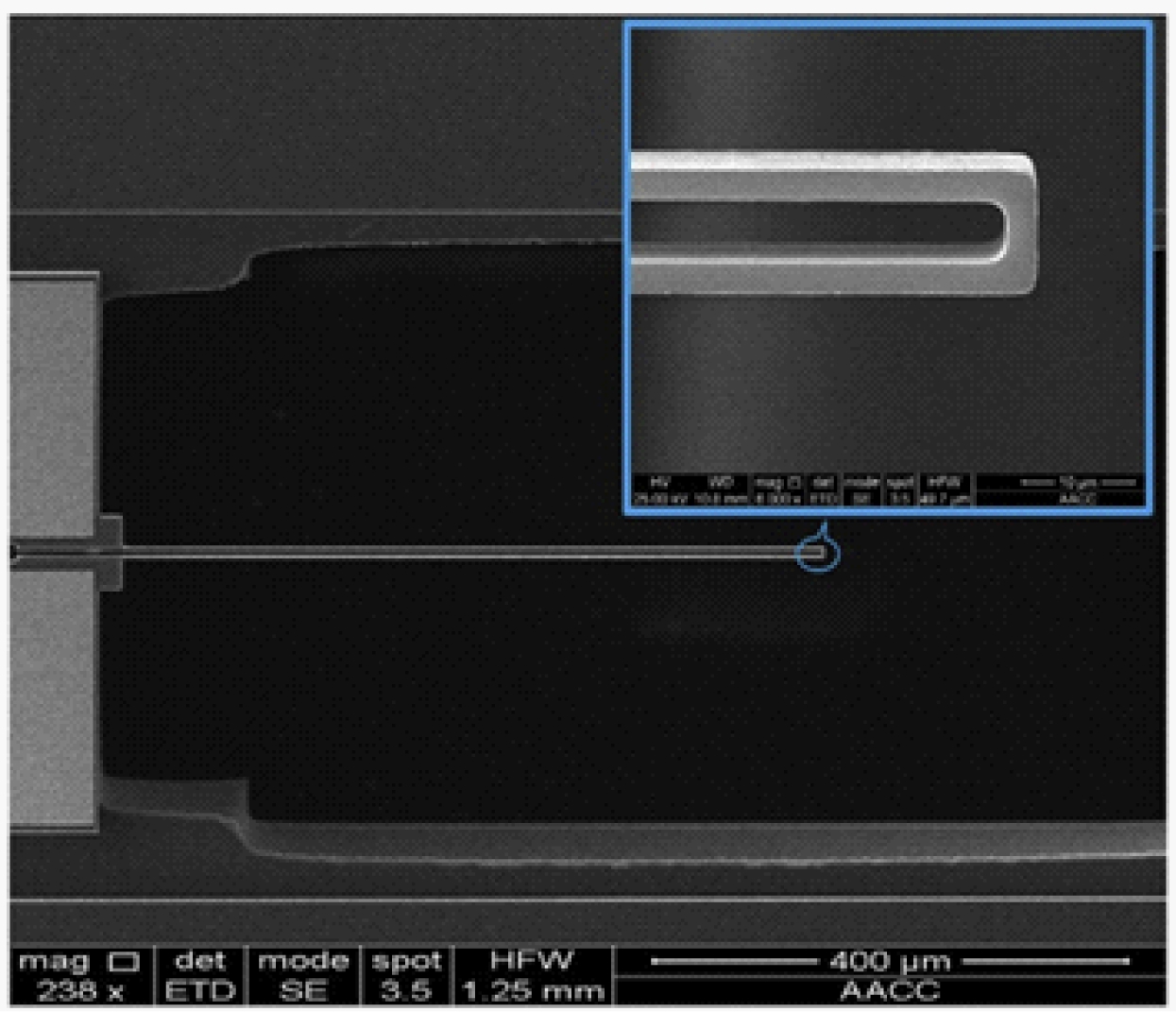
图8 热导式硅悬臂结构的扫描电镜图
Fig.8 SEM image of thermal conductivity silicon cantilever
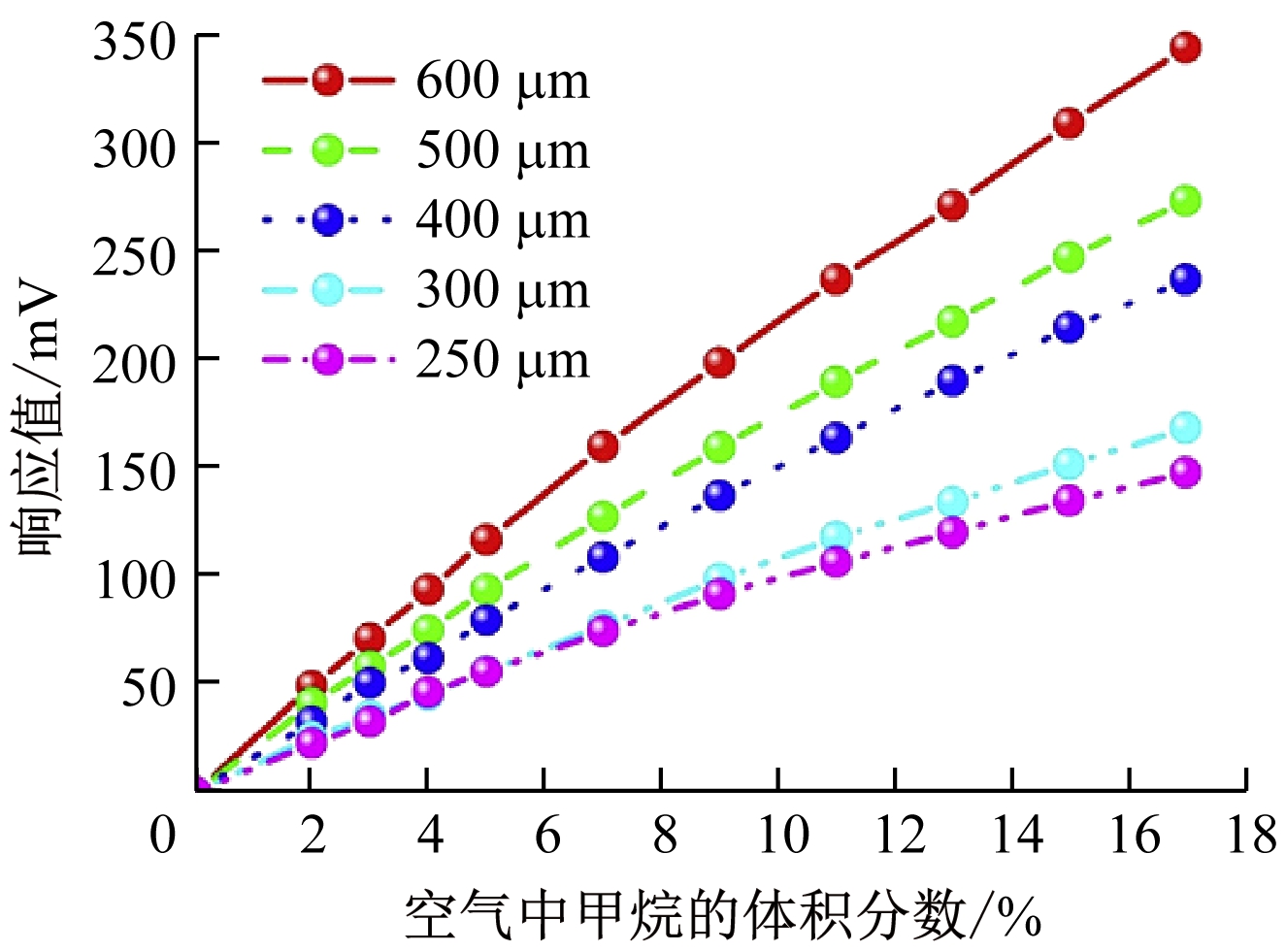
图9 硅悬臂热导式甲烷传感器对不同体积分数
甲烷的响应值曲线
Fig.9 Response values curves of silicon cantilever
type thermal conductivity methane sensor to different
volume fractions of methane
综上所述,热导式甲烷传感器一般需要在500 ℃以上工作,故而功耗难以降低。利用硅悬臂的焦耳自加热效应可以显著降低功耗,并可以测量体积分数为0~17%的甲烷。
2.3 低功耗电导式甲烷传感器
2.3.1 室温电导式甲烷传感器
电导式甲烷传感器通常需要在室温以上工作,加热器是功耗的主要来源。如果传感器可以在室温下工作,从而大大降低了功耗。常见的室温电导式甲烷传感材料有碳纳米管、石墨烯、过渡金属氧化物或者其复合物。
Lu Yijiang等[19]发现钯掺杂的单壁碳纳米管可以在室温下对甲烷产生响应。K.Roy等[20]利用电沉积法简便地制备了碳纳米管,也实现了室温下对甲烷的测量,然而碳纳米管在室温下对甲烷响应时间较长,大于60 s。Li Zhongping等[21]发现钯掺杂的碳纳米管及1,6-已烷二胺复合物可以在室温下对体积分数为0~16%的甲烷产生线性响应,且响应时间小于35 s,然而该材料对湿度比较敏感。C.Jesus 等[22]利用电化学法制备铂掺杂的单壁碳纳米管材料,实现了体积分数为5×10-5~2×10-4甲烷的室温响应。R.Afrin 等[23]发现-COOH基团修饰的碳纳米管可以在室温下对甲烷响应,且响应时间小于30 s,然而该材料对一氧化碳的响应更快。M.Assar等[24]发现氧化石墨烯可以在室温下对甲烷响应,且热处理或者激光辐照都可以提高响应。Chen Xiaoyu等[25]设计了锂离子掺杂的碳纳米管室温甲烷传感器,掺杂显著提高了碳纳米管对甲烷的传感响应,该传感器对一氧化碳和氨气的响应较慢,选择性好,且长期稳定性和重复性均较好,传感器敏感材料如图10所示。
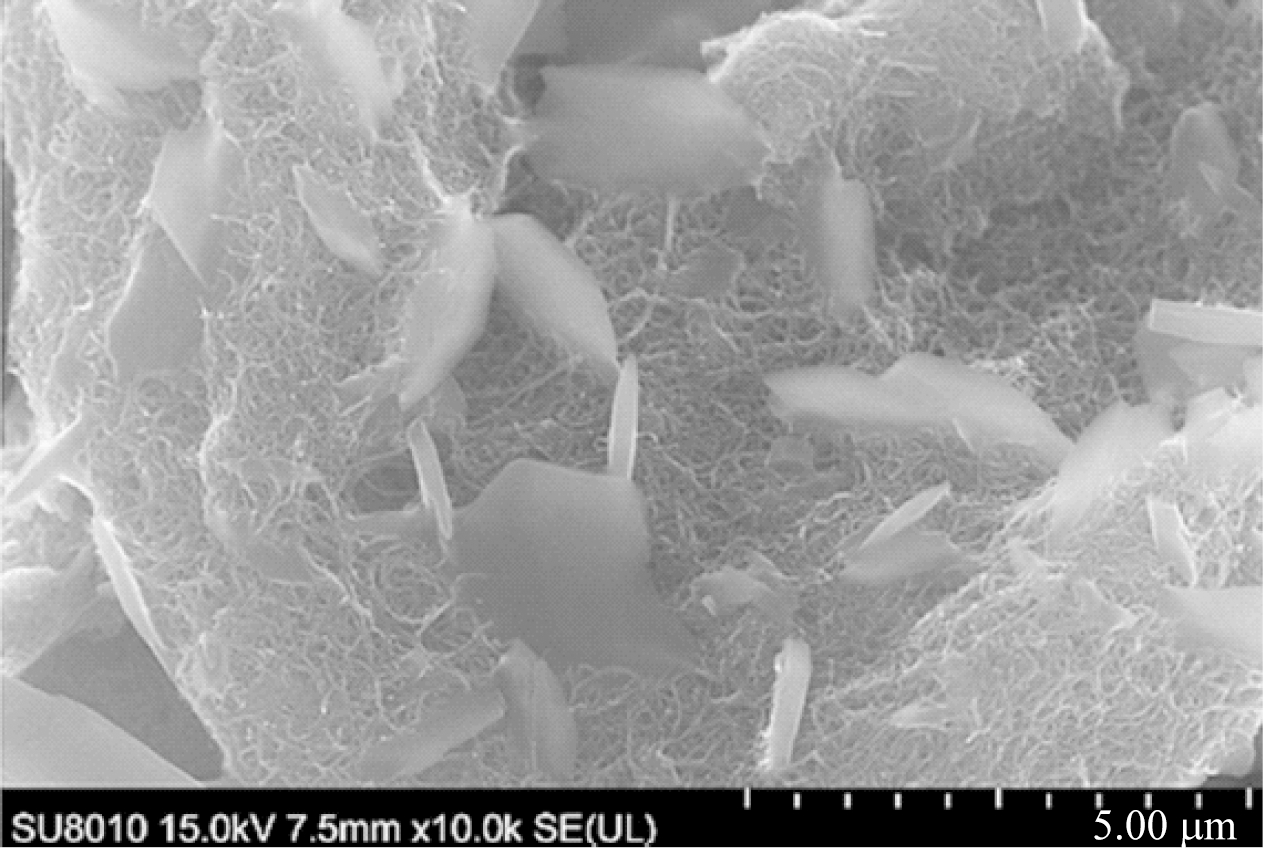
图10 锂离子掺杂碳纳米管的扫描电镜图
Fig.10 SEM image of Li+ doped CNT
B.Costello 等[26]利用紫外LED等照射氧化锌薄膜设计了室温甲烷传感器,但该传感器响应较慢。M.Akermi 等[27]发现PEG400可以增强氧化锌颗粒对甲烷的室温响应。D.Haridas 等[28]研究紫外辐照下钯掺杂的二氧化锡薄膜可以实现室温下对甲烷的高响应,然而响应时间非常长。A.Mosahebfard 等[29]认为硫化铅纳米晶可以在室温下对体积分数为1%~5%的甲烷响应。P.Tshabalala等[30]发现二氧化钛纳米棒可以在室温下实现对低浓度甲烷的高响应,同时该材料对氢气和氨气的响应较慢。甲烷响应的改善与较大的表面积和敏感材料的点缺陷有关,然而该材料的响应速度较慢。S.Nasresfahani 等[31]发现钯掺杂的二氧化锡-还原氧化石墨烯实现了对体积分数为8×10-4~1.6×10-2的甲烷的室温响应,然而响应时间仍然很长。Wu Chunlei等[32]设计了基于锂掺杂的多孔材料的室温甲烷传感器,该传感器对甲烷响应较快且选择性较好,同时还具有一定的抗湿和抗尘能力。
综上可知,室温电导式甲烷传感器是具有广阔前景的矿用低功耗甲烷传感器,然而一般响应时间比较长,对湿度很敏感,且难以实现对一氧化碳等气体的选择性响应,其性能改善取决于传感材料的选取。
2.3.2 微加热板型电导式甲烷传感器
D.Briand 等[33]设计了基于微加热板的电导式甲烷传感器,基于氮化物的微加热板可以加热至700 ℃,可以在芯片上对敏感材料进行热处理。基于钯掺杂氧化锡的传感器可以同时检测甲烷和一氧化碳。P.Bhattacharyya 等[34]设计了基于氧化锌纳米晶薄膜的微加热板型甲烷传感器,在250 ℃时该传感器可以对体积分数为1%的甲烷产生较快响应,响应时间仅为8.3 s,功耗为120 mW。该传感器可以在100 ℃对体积分数为0.5%以上的甲烷响应,功耗仅为40 mW,高响应值与钯银合金接触电极的高催化性能有关。J.Yu等[35]在微加热板上制备了条形的氧化锡薄膜敏感材料,提高了微加热板型传感器高温操作下的稳定性。该传感器可以持续稳定运行300 h,且能够同时测量甲烷和一氧化碳。A.Andio 等[36]利用喷墨打印技术在微加热板上得到了纳米颗粒、微米颗粒和微米球3种形貌的氧化锡薄膜, 3种材料均可以测量体积分数为0~1%的甲烷,其中微米颗粒的响应最差,在450 ℃时纳米颗粒的响应值最高,在550 ℃时微米球的响应值最高。可见氧化锡纳米颗粒是三者中最优的敏感材料。传感器如图11所示,二氧化锡材料均匀地分布在微加热板中心区域。
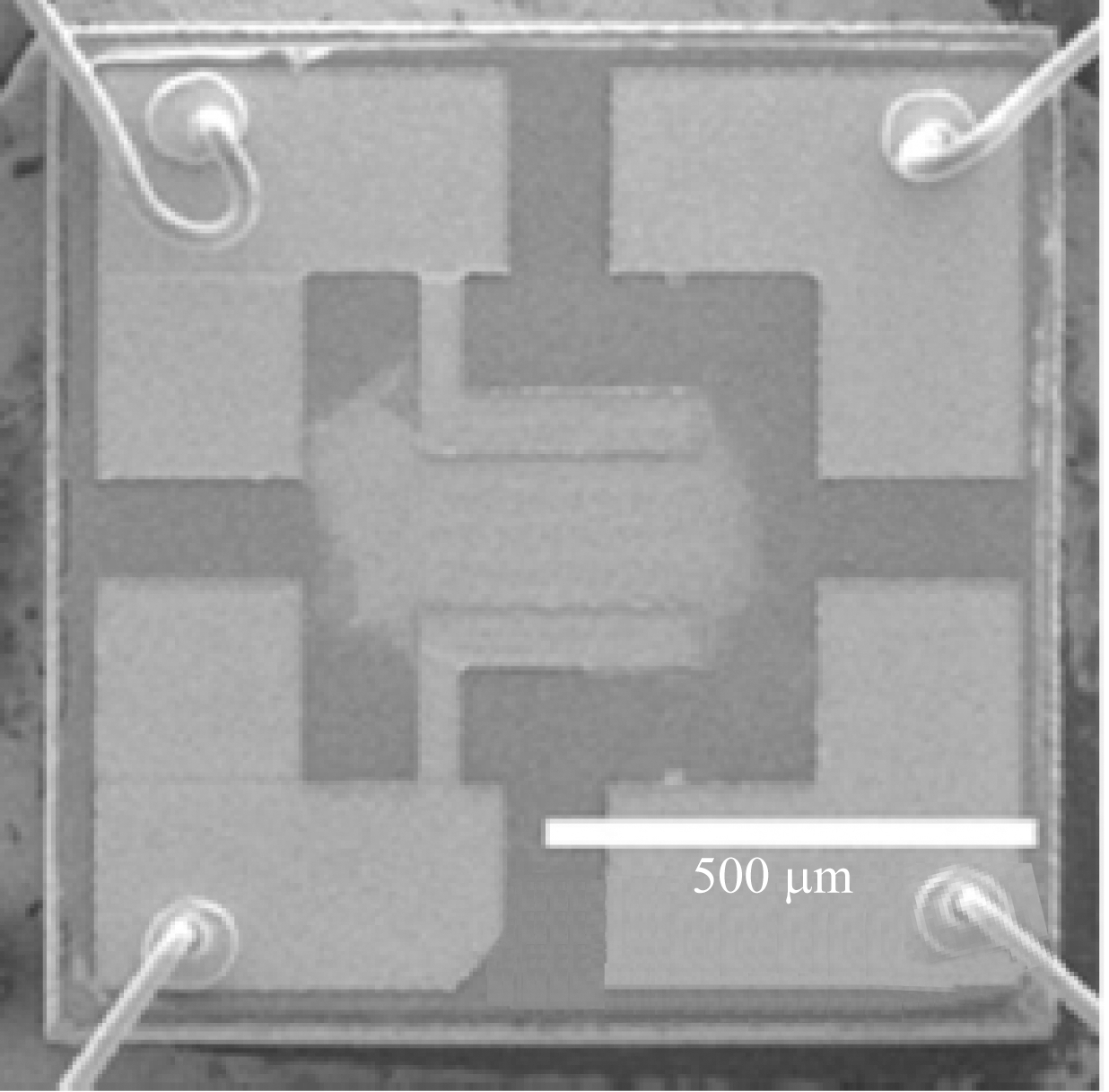
图11 基于二氧化锡薄膜的微加热板型电导式
甲烷传感器扫描电镜图
Fig.11 SEM image of microhotplate type electrical
conductivity methane sensor based on SnO2 thin film
综上可知,微加热板型电导式甲烷传感器功耗相对较低,结合特定的纳米材料,可以在较低工作温度下实现对甲烷的响应,具有低浓度甲烷监测应用前景,然而该类传感器的长期稳定性和基线漂移问题有待解决。
3 低功耗甲烷传感器发展方向
(1) 低功耗催化燃烧式甲烷传感器可以测量低浓度甲烷,然而其稳定性不高,未来的研究方向是改进封装或者催化材料,从而增强其抗毒化的能力。同时需结合人工智能和机器学习等先进算法研究免人工校准的低功耗催化燃烧式甲烷传感器。
(2) 低功耗热导式甲烷传感器可同时测量低浓度和高浓度甲烷,在矿井中运行稳定,有分布式无线甲烷传感器应用前景。未来的发展方向是改进电路模组,实现睡眠-唤醒运行模式,尽可能地降低元件和电路的功耗;同时研究传感器元件和外围电路的集成技术,以实现片上集成式热导式甲烷传感系统,降低整体运行功耗。
(3) 低功耗室温型电导式甲烷传感器结构简单,能实现室温下甲烷的测量,显示出广阔的应用前景。然而室温型电导式甲烷传感器一般对环境湿度很敏感,基线易偏移,故而需要进一步改进敏感材料和封装工艺,保证传感器的稳定运行。微加热板型电导式甲烷传感器的材料制备技术有待改进,目前还主要通过转移途径在微加热板上添加敏感材料,敏感材料对电极的粘附力差,器件重复性和可靠性均较差。应用磁控溅射方法将半导体氧化物敏感材料沉积到电极上可提高材料的粘附力,从而提高器件的重复性和可靠性。同时微加热板型电导式甲烷传感器的长期工作稳定性和可靠性需进一步研究和改进。
(4) 从整个传感系统角度看,传感元件外围电路的功耗有时甚至高于传感元件本身。未来的方向是研究片上集成式甲烷传感器,从而大大降低外围电路功耗,形成极低功耗甲烷传感器。此外,分布式无线低功耗甲烷传感器未来应实现免人工标校或自校准,需要研究先进的传感器自校准算法。
4 结论
(1) 随着煤矿智能化建设的需求日益迫切,目前煤矿井下普遍采用的有线供电催化燃烧式甲烷传感器存在覆盖区域有限、功耗高等不足。分布式无线甲烷传感器覆盖范围广、功耗低,在煤矿智能安全监测中有较广阔的应用前景。低功耗、智能化、微型化的分布式无线甲烷传感器亟待研究。
(2) 低功耗甲烷传感器主要有催化燃烧式、热导式、电导式3种。低功耗催化燃烧式甲烷传感器可以测量低浓度甲烷,然而易中毒,稳定性不高,功耗相对较高;未来的研究方向是改进封装工艺或者催化材料,以增强其抗毒化的能力,同时需结合人工智能和机器学习等先进算法研究免人工校准的低功耗催化燃烧式甲烷传感器。低功耗热导式甲烷传感器具有全量程测量甲烷的能力,可同时测量低浓度和高浓度甲烷,在矿井中可以稳定运行,且对井下环境的适应力强,具有分布式无线甲烷传感器应用前景,未来的发展方向是改进电路模组,实现睡眠-唤醒运行模式,同时研究传感器元件和外围电路的集成技术,以实现片上集成式热导式甲烷传感系统,降低整体运行功耗。低功耗电导式甲烷传感器分为室温型和微加热板型,室温型电导式甲烷传感器功耗较低,但通常响应时间较长;微加热板型电导式甲烷传感器功耗相对较低,结合特定的纳米材料,可以在较低工作温度下实现对甲烷的测量,具有低浓度甲烷监测应用前景,但微加热板型电导式甲烷传感器一般对环境湿度很敏感,基线易偏移,敏感材料对电极的粘附力差,器件重复性和可靠性均较差,故而需要进一步改进敏感材料和封装工艺,应用磁控溅射方法将半导体氧化物敏感材料沉积到电极上可提高材料的粘附力,从而提高器件的重复性和可靠性,同时需结合算法纠正基线偏移,保证传感器的稳定运行。
(3) 从整个传感系统角度看,传感元件外围电路的功耗有时甚至高于传感元件本身,未来的方向是研究片上集成式甲烷传感器,从而大大降低外围电路功耗,形成极低功耗甲烷传感器。
(4) 煤矿安全监控对低功耗甲烷传感器的可靠性和环境适应性提出了更高的要求,且甲烷传感器必须符合本安要求。目前低功耗甲烷传感器的可靠性和煤矿环境适应性研究不足,需要进行进一步实验研究。
[1] 霍中刚,武先利.互联网+智慧矿山发展方向[J].煤炭科学技术,2016,44(7):28-33.
HUO Zhonggang,WU Xianli.Development tendency of Internet plus intelligent mine[J].Coal Science and Technology,2016,44(7):28-33.
[2] 丁恩杰,金雷,陈迪.互联网+感知矿山安全监测系统研究[J].煤炭科学技术,2017,45(1):129-134.
DING Enjie,JIN Lei,CHEN Di.Study on safety monitoring and control system of Internet+perception mine[J].Coal Science and Technology,2017,45(1):129-134.
[3] 王安,杨真,张农,等.矿山工业4.0与“互联网+矿业”:内涵、架构与关键问题方向[J].中国矿业大学学报(社会科学版),2017,19(2):54-60.
WANG An,YANG Zhen,ZHANG Nong,et al.Connotation,framework and critical issues of mine industry 4.0 and Internet plus mining[J].China University of Science and Technology Journal(Social Sciences),2017,19(2):54-60.
[4] 吴水平.矿用甲烷传感器研究进展及存在的问题[J].能源与技术管理,2016,41(5):45-46.
WU Shuiping.The existing problems and research progress of methane sensors for coal mine[J].Energy Technology and Management,2016,41(5):45-46.
[5] VEHBI C,GERHARD P H.Industrial wireless sensor networks:challenges,design principles,and technical approaches[J].IEEE Transactions on Industrial Electronics,2009,56(10):4258-4265.
[6] DUCSO C,ADAM M,FUJES P,et al.Explosion-proof monitoring of hydrocarbons by mechanically stabilised,integrable calorimetric microsensors[J].Sensor and Actuators B:Chemical,2003,95:189-194.
[7] LU Xiaoqing,ZHANG Zhengyong,KONG Deyi.A catalytic sensor using MEMS process for methane detection in mines[C]//Proceedings of the 2007 International Conference on Information Acquisition,Jeju,2007.
[8] XU Lei,LI Tie,GAO Xiuli,et al.A high-performance three-dimensional microheater-based catalytic gas sensor[J].IEEE Electron Device Letters,2009,56(10):4258-4265.
[9] JANG W J,KIM I H,JEONG Y S,et al.Characteristics of fabricated catalytic combustible micro gas sensor with low power consumption for detecting methane leakage of compressed natural gas bus[J].Journal of Electroceramics,2013,31:280-285.
[10] SU Jiacan,CAO Liehu,LI Liang,et al.Highly sensitive methane catalytic combustion micro-sensor based on mesoporous structure and nanocatalyst[J].Nanoscale,2013,5:9720-9725.
[11] EVGENY E K,EVGENY F K,SUCHKOVA A S,et al.Energy efficient planar catalytic sensor for methane measurement[J].Sensors and Actuators A:Physical,2013,194:176-180.
[12] MA Hongyu,DING Enjie,WANG Wenjuan.Power reduction with enhanced sensitivity for pellistor methane sensor by improved thermal insulation packaging[J].Sensors and Actuators B:Chemical,2013,187:221-226.
[13] LU Wenshuai,JING Gaoshan,BIAN Xiaomeng,et al.A quartz-based micro catalytic methane sensor by high resolution screen printing [J].Journal of Micromechanics and Microengineering,2016,26:025021.
[14] LU Wenshuai,JING Gaoshan,BIAN Xiaomeng,et al.Micro catalytic methane sensors based on 3D quartz structures with cone-shaped cavities etched by high-resolution abrasive sand blasting[J].Sensors and Actuators A:Physical,2016,242:9-17.
[15] BARSONY I,DAM M,FUJES P,et al.Efficient catalytic combustion in integrated micropellistors[J].Measurement Science and Technololy,2009,20:124009.
[16] MA Hongyu,WANG Wenjuan,LIU Xiaowen.Methane detection with high temperature all-silicon microheater[C]//IEEE Sensors,2014.
[17] MA Hongyu,QIN Shunli,WANG Liying,et al.The study on methane sensing with high-temperature low-power CMOS compatible silicon microheater[J].Sensors and Actuators B:Chemical,2017,244:17-23.
[18] MA Hongyu,DU Yana,WEI Minsong,et al.Silicon micro-heater based low-power full-range methane sensing device[J].Sensors and Actuators A:Physical,2019,295:70-74.
[19] LU Yijiang,LI Jing,HAN Jie,et al.Room temperature methane detection using palladium loaded single-walled carbon nanotube sensors[J].Chemical Physics Letters,2004,391:344-348.
[20] ROY K,CHOWDHURY P,PAL A K.Room temperature sensor based on carbon nanotubes and nanofibres for methane detection[J].Vacuum,2005,77:223-229.
[21] LI Zhongping,LI Junfen,WU Xu,et al.Methane sensor based on nanocomposite of palladium/multi-walled carbon nano-tubes grafted with 1,6-hexanediamine[J].Sensors and Actuators B:Chemical,2009,139:453-459.
[22] JESUS C,SANTIAGO D,CASILLAS G,et al.Platinum electrodeposition on unsupported single wall carbon nanotubes and its application as methane sensing material[J].Journal of the Electrochemical Society,2013,160(2):H98-H104.
[23] AFRIN R,SHAH N A.Room temperature gas sensors based on carboxyl and thiol-functionalized carbon nanotubes buckypapers[J].Diamond & Related Materials,2015,60:42-49.
[24] ASSAR M,KARIMZADEH R.Enhancement of methane gas sensing characteristics of graphene oxide sensor by heat treatment and laser irradiation[J].Journal of Colloid and Interface Science,2016,483:344-348.
[25] CHEN Xiaoyu,HUANG Zonghou,LI Jia,et al.Methane gas sensing behavior of lithium ion doped carbon nanotubes sensor[J].Vacuum,2018,154:120-128.
[26] COSTELLO B,EWENR J,RATCLIFFE N M,et al.Highly sensitive room temperature sensors based on the UV-LED activation of zinc oxide nanoparticles[J].Sensors and Actuators B:Chemical,2008,134:945-952.
[27] AKERMI M, SAKLY N,CHAABANE R B,et al.Effect of PEG-400 on the morphology and electrical properties of ZnO nanoparticles application for gas sensor[J].Materials Science in Semiconductor Processing,2013,16:807-817.
[28] HARIDAS D,GUPTA V.Study of collective efforts of catalytic activity and photoactivation to enhance room temperature response of SnO2 thin film sensor for methane[J].Sensors and Actuators B:Chemical,2013,182:741-746.
[29] MOSAHEBFARD A,JAHROMI H D,SHEIKHI M H.Highly sensitive,room temperature methane gas sensor based on lead sulfide colloidal nanocrystals[J].IEEE Sensors Journal,2016,11:4174-4179.
[30] TSHABALALA P,SHINGANGE K,MHLONGO G H,et al.Fabrication of ultra-high sensitive and selective CH4 room temperature gas sensing of TiO2 nanorods:detailed study on the annealing temperature[J].Sensors and Actuators B:Chemical,2017,238:402-419.
[31] NASRESFAHANI S,SHEIKHI M H,TOHIDI M,et al.Methane gas sensing properties of Pd-doped SnO2/reduced grapheme oxide synthesized by a facile hydrothermal route[J].Materials Research Bulletin,2017,89:161-169.
[32] WU Chunlei,LI Jia,GUO Zengzeng,et al.Methane sensors based on lithium doped porous materials for coal mine safety application[J].Electrochemical Society,2020,167(14):1455-1462.
[33] BRIAND D,KRAUSS A,SCHOOT D,et al.Design and fabrication of high-temperature micro-hotplates for drop-coated gas sensors [J].Sensors and Actuators B:Chemical,2000,68:223-233.
[34] BHATTACHARYYA P,BASU P K,MONDAL B,et al.A low power MEMS gas sensor based on nanocrystal line ZnO thin films for sensing methane[J].Microelectronics Reliability,2008,48:1772-1779.
[35] YU J,TANG Z A,YAN G Z,et al.An experimental study on micro-gas sensors with strip shape tin oxide thin films[J].Sensors and Actuators B:Chemical,2009,139:346-352.
[36] ANDIO A,BROWNING N,MORRIS A,et al.Comparison of gas sensor performance of SnO2 nanostructures on micro-hotplate platforms[J].Sensors and Actuators B:Chemical,2012,165:13-18.
